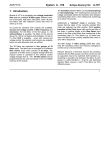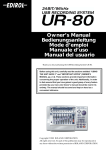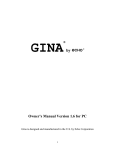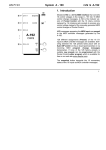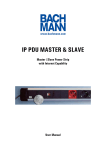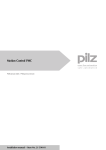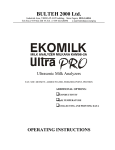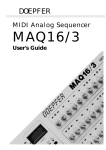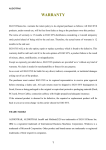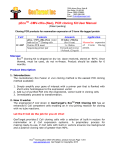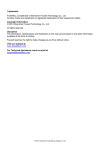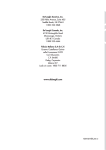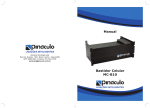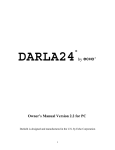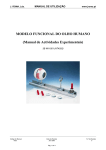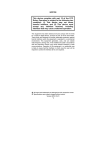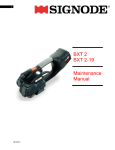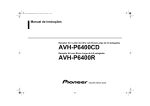Download POCKET ELECTRONIC
Transcript
DOEPFER MUSIKELEKTRONIK GMBH POCKET ELECTRONIC (Universal Midi Control Electronics ) Installation and User's Guide © 2006 by Doepfer Musikelektronik Table of contents Table of contents ........................................................................................................................................ 2 Electrical safety / EMC compatibility........................................................................................................... 2 Warranty ..................................................................................................................................................... 3 Introduction................................................................................................................................................. 4 Connection and Installation ........................................................................................................................ 5 Power Supply (1) .................................................................................................................................... 5 Midi Out Socket (2) ................................................................................................................................. 5 Midi In Socket (3) .................................................................................................................................... 7 Connectors for the 16 controls (4) .......................................................................................................... 7 Connector for snapshot button and LED (5) ......................................................................................... 10 DIP Switches (6) ................................................................................................................................... 10 Mounting................................................................................................................................................... 11 Controls and Operation ............................................................................................................................ 12 Functions of the LED ............................................................................................................................ 12 Functions of the button (momentary switch) ........................................................................................ 12 Functions of the DIP switch .................................................................................................................. 13 Changing the preset during power on................................................................................................... 15 Check list .................................................................................................................................................. 16 Extent of delivery ...................................................................................................................................... 16 Appendix 1: Detailed description of the factory presets ........................................................................... 17 Appendix 2: Creating your own presets.................................................................................................... 29 Electrical safety / EMC compatibility POCKET ELECTRONICS (abbreviated "PE" in the following) is a so-called OEM product (OEM original equipment manufacturer) that cannot be used independently but has to be combined with additional electrical or electronical equipment to become a working device (e.g. potentiometers, switches, power supply, case/housing). The manufacturer of PE does not know the final assembly of the complete device in which the PE is used as a part of the complete device. The final responsibility with regard to electrical safety and electromagnetic compatibility is up to the user who is assembling the complete device. Electronic basic knowledge is required to install PE and to connect the controls resp. control voltages. If you are not sure whether your knowledge is sufficient please consult an expert. We cannot take back modules that became defective because of wrong installation or wrong connection of the controls or voltages. Please pay attention to the following items: The power supply used in combination with the PE has to be a closed type (in Germany a power supply with VDE approval is required). Normally an AC adapter with plastic case is used. It is not allowed to use open power supplies whith open mains voltage access (e.g. via mains lead, pcb tracks, electronic parts). On the PE preventing measures against electromagnetic radiation are taken (RF filters at the power supply input and the Midi lines). But it is impossible to estimate to what extend the components added by the user affect the EMC properties of the complete assembly. Therefore the complete device has to be shielded against electromagnetic radiation (incoming and outgoing). These demands are normally met by a closed metal case that covers the complete assembly. The metal case should be connected to GND of the PE. Page 2 Pocket Electronic User's Guide Warranty • • • • • • • • • • • Applying any negative voltage (< 0V) or positive voltage above +5V (> +5V) to one of the 16 analog inputs (JP1, JP2) will destroy the circuit ! If potentiometers and/or switches are connected between GND and +5V of PE as described in this manual no problems will occur. When external control voltages are connected to PE the user has to pay attention that the voltages applied are strictly within GND and +5V referenced to GND of PE ! Do not solder directly to any of the pin headers but use female connectors to make the connections between PE and the potentiometers, switches or voltages. A cable set that contains all required connectors and cables is included with PE. Carry out all connections in the off-state of PE (i.e. when powered-off only) ! Do not power on PE (i.e. do not connect the power supply to the corresponding jack socket) before all 16 analog inputs are connected. Do not leave analog inputs unconnected ! The 4-pin connector is allowed to connect a button and LED only as described in the manual. Do not connect any other electronic parts or voltages. PE electronics is an electrostatic sensitive device. Avoid any electrostatic charges ! Do not touch the analog inputs with your fingers ! Avoid short circuits ! Ignoring any of these items will cause warranty loss ! Return of the PE within the 2 weeks return time limit (valid only in Germany) is only possible if all these items have been met. Return of used cable sets is not possible. We also cannot take back modules that have been soldered by the user. User's Guide Pocket Electronic Page 3 Introduction • • • • • • • • • • • PE is an universal electronics DIY kit to built your own Midi control box. Up to 16 controls can be connected to PE transmitting 16 different Midi messages on different (or even the same) Midi channels. The most important messages are probably the Midi Control Change messages – often simply called "Midi controllers". In the following we are sometimes talking about Midi controllers though other Midi messages are possible. The available Midi messages are described in the manual of the editor software. Typical examples for controls that can be used are rotary potentiometers, fader/slider potentiometers, momentary switches, toggle switches, foot switches or foot controllers). The controls are not included but have to be added by the customer. Even voltages sources can be used instead of the controls provided that the voltages applied are strictly within the range 0...+5V (referenced to PE GND)! Voltages beyond this range will destroy the electronics ! The PE configuration (i.e. the assignment of Midi messages and channels to the controls in the 128 presets) is made with a editor program (PC version, free download from our web site www.doepfer.com ). It enables the user to program his own 128 presets. Sorry we do not offer a Mac version of the editor program. But we have available the OEM version of Emagic's Sounddiver (both PC and Mac version, extra charge). The factory presets are described in the appendix of this manual These can be changed with the editor program. The 16 controls resp. control voltages are connected to double row pinheaders (10 pins each). To these headers two 10 pin ribbon cables are put up. The terminals of the controls are soldered to the free ends of the ribbon cables. In this way the controls might be disconnected from the electronics very easily. PE is equipped with Midi In and Midi Out. The incoming Midi messages are merged to the data generated by PE provided that the Midi data does not exceed a certain amount. In this way several PE can be linked together to obtain larger controller arrays with more than 16 controls. PE is available only as an assembled and tested pc board (about 80 x 56 x 25 mm). PE includes two 10 pin ribbon cables (about 30 cm each), button and LED (snapshot function) and the power supply. An external power supply (7-12VDC@min. 100mA) is required for the PE. It is included for all shipments within Germany (230V version with European mains plug). For shipments outside Germany please ask your local representative or dealer. We do not offer a suitable housing as this would have to be completely different for various combinations of controls. Page 4 Pocket Electronic User's Guide Connection and Installation Please pay attention to the following notes ! Electronic basic knowledge is required to install the PE electronics and to connect the controls resp. control voltages. If you are not sure whether your knowledge is sufficient please consult an expert. We cannot take back modules that became defective because of wrong installation or wrong connection of the controls or voltages. We also cannot take back modules or cables which have been soldered by the user. Power Supply (1) PE does not have a built-in power supply. Instead it uses a plug-in type external power supply (AC adapter). One reason for this feature is electrical safety. Keeping danger voltages (main) out of the PE increases the electrical safety. Therefore an external power supply of high quality and safety should be used. If PE is used in Germany the external power supply has to be VDE approved. Another reason for the external power supply is the fact that mains voltages and plug types vary considerably from country to country. Using a plug-in external supply PE can be used any where with a locally purchased power supply, thus keeping the retail price down. The power supply has to be able to deliver 7-12 VDC unstabilized voltage, as well as a minimum current of 100mA. PE is switched ON by plugging the AC adapter into a wall outlet and connecting it to the appropriate jack on the PE board. There is no separate ON/OFF switch. After power on the preset adressed by the settings of the DIP switch is called up, as well as the current settings for Midi thru mode and master channel. For details please refer to the user's manual of the free editor software. If the polarity of the power supply is incorrect, PE will not function. However, there is no danger of damage to the circuitry since it is protected by a diode. The correct polarity is: outside ring = GND, inside lead = +7...12V. A power supply for 230V mains voltage with European type mains plug is included with the PE (valid only within Europe, for other countries ask you local Doepfer representative or dealer). Midi Out Socket (2) Connect the Midi Out socket with Midi In of the device to be controlled by PE (e.g. Computer, Synthesizer, second daisy-chained PE) via a suitable Midi cable. If you want to control more than one Midi device you have to use daisy chain Midi Thru / Midi In connection of the devices ore use a external Midi Thru box. User's Guide Pocket Electronic Page 5 Overview: Pocket Electronic Connectors (4) connectors for the potentiometers resp. switches (JP1, JP2) (1) power supply 7-12V / 100mA DC (BU3) Page 6 (6) DIP switch for preset selection (2) Midi Out (BU2) Pocket Electronic (5) connector for snapshot button and LED (ST1) (3) Midi In (BU1) User's Guide Midi In Socket (3) The PE features a Midi input. This input may be connected to another Midi device (e.g. Midi keyboard). The incoming Midi data are merged to the data generated by PE. The Midi input may be used as well for daisy-chaining several PE. The Midi input of PE is not suitable for large amounts of Midi data (e.g. SysEx strings or Midi messages coming from an computer sequencer) as the PE has only a small Midi in buffer. In case of large amounts of incoming Midi data loss or delay of data may occur. The Midi input is also required when PE is programmed with the editor software. In this case the Midi input of PE has to be connected to the Midi output of the computer on which the editor program is running. The Midi output of PE has to be connected to the Midi input of the computer. Details can be found in the manual of the editor program. If the merge feature of the PE is not required and the programming option is not used the Midi input is left open. Connectors for the 16 controls (4) The two pin headers JP1 and JP2 are used to connect the controls. Both pin headers have available these signals: GND, +5V and 8 control voltage inputs (range 0...+5V). Remark: In the following the terms GND (= abbreviation of ground) and 0V (zero volts) are used synonymous. The control voltages are normally generated by rotary or fader potentiometers that are connected between GND and +5V. In this case the wiper of the potentiometers outputs a voltage in the range 0...+5V while the potentiometer is operated. Another possibility is the connection of momentary switches or toggle switches. The lower part of the sketch on the next page shows the pinout of the two pin headers JP1 and JP2 (same orientation as the picture on page 5). The pins labelled 1 ... 16 are the 16 control voltage inputs. Normally two 10 pin female connectors with ribbon cables are plugged to the pin headers JP1 and JP2. The female connectors with ribbon cables are included with the PE. The controls (e.g. potentiometers, switches) are soldered to the open ends of the ribbon cable. The upper part of the sketch shows the pinout of the 10 wires of the ribbon cables. We strictly recommend this type of wiring but not to solder the wires directly to the pin headers JP1 and JP2. Usage of the ribbon cables with female connectors allows to disconnect the controls from the electronics very easily. User's Guide Pocket Electronic Page 7 10 pin female connector with ribbon cable 10 pin female connector with ribbon cable Rotary or slider potentiometers are connected in this way: • • • lower resp. left end terminal to GND wiper / middle terminal to one of the analog inputs 1 ... 16 upper resp. right end terminal to +5V Connection of a rotary potentiometer Page 8 Connection of a slider potentiometer Pocket Electronic User's Guide Linear potentiometers with resistance values 4k7 ... 100k can be used. We recommend 10k (linear). Momentary or toggle switches can be used in two different ways: version 1 version 2 state of rest Midi data voltage 0 0V 127 +5V aktive state Midi data voltage 127 +5V 0 0V Simple momentary switches (1 contact, open at rest) or simple toggle switches (1 contact on/off) are required. According to the desired behaviour (version 1 or 2 in the above table) the switch has to be wired correspondingly: Connection of a momentary or toggle switch (version 1) Connection of a momentary or toggle switch (version 2) In both cases an additional 10k resistor is required (possible range 4k7 to 100k) to pull the analog input to a defined state during the switch is open. • Version 1: The resistor is soldered between GND and the control voltage input 1...16. This way the input is pulled to GND ( =0V corresponding to Midi data 0) as long as the switch is left open. When the switch is closed the voltage jumps to +5V corresponding to Midi data 127. • Version 2: The resistor is soldered between +5V and the control voltage input 1...16. This way the input is pulled to +5V (corresponding to Midi data 127) as long as the switch is left open. When the switch is closed the voltage jumps to 0V corresponding to Midi data 0. Sixteen 10k-resistors (range 4k7 ... 100k) are enclosed witch each PE delivery. Suitable resistors are available in each electronic shop too (value: 10k, power: ¼ W, tolerance: 5%, material: carbon). Unused inputs have to be connected to GND. Avoid open inputs ! An open input will cause the transmission of random Midi data causing undesirable side effects at the Midi receiver (e.g. Midi overflow or random parameter fluctuations). User's Guide Pocket Electronic Page 9 Connector for snapshot button and LED (5) PE has two simple controls available: a so-called snapshot button and a LED. If the user wants to have available these controls they are connected to the pin header ST1 in this way: The button is a simple momentary switch (open at rest) and any standard LED can be used (3 or 5 mm or rectangle, red/yellow/green/blue/white color). Pay attention to the polarity of the LED. Normally the cathode (minus terminal) is indicated by a shortened pin and is the bigger electrode inside the LED. A 4 pin female connector can be used for wiring. This allows to disconnect the button and LED from the electronics very easily. The LED is essentially used as a control display, the button is used to send off all 16 Midi messages with the data corresponding to the present positions of the 16 controls (snapshot function). The functions of the snapshot button and the LED are described in detail in the operation chapter of this manual. DIP Switches (6) The positions of the 8 switches of S2 determine the number of the preset that is called up during power on. For details please refer to chapter "controls and operation". Page 10 Pocket Electronic User's Guide Mounting Before PE is put into operation the board has to be fixed on a suitable support and built into a metal case together with the controls (refer to EMC notes on page 2). The metal case has to be connected to GND of PE. We recommend to use the metal plate of the voltage regulator 7805/IC6 or the GND terminal of the power supply socket for this connection. The board measures about 80 x 56 x 25 mm. Five mounting holes with 3 mm diameter are available for mounting the board inside the case e.g. with distance sleeves or spacers (> 5 mm in length) and suitable screws. Pay attention that no short circuits are made – neither on the top of the board (electronic parts) nor on the bottom (solder points or pcb tracks). In case of doubt use isolating plastic parts (e.g. plastic screws, nuts and washers) for mounting. Position of the mounting holes (measures in mm) User's Guide Pocket Electronic Page 11 Controls and Operation Apart from the 16 potentiometers and/or switches that are connected to JP1 and JP2 PE has these controls available: • • • momentary switch/button (connected to ST1, please refer to page 10) LED (connected to ST1, please refer to page 10) 8 pin DIP switch (please refer to page 10) Functions of the LED After power on the LED will stay lit for around one second when the power is first applied to the PE . If this does not happen probably the power supply used is not suitable (i.e. correct polarity, voltage and current) or defective. Under normal operation the LED indicates MIDI input activity, and also MIDI output activity when moving the potentiometers or operating the switches connected to PE . The LED also indicates these situations: • The status of the Snapshot function (details see "functions of the button") • Data and status when setting the Master channel • Indication that a preset has been changed • Any error at the MIDI input • Whenever an overflow at the Midi input is recognized by PE the LED turns permanently on. This is an indication that the merge capacity of PE has been exceeded, or that SysEx messages intended for PE have been transmitted too fast. In both cases the Midi data have been probably received or transmitted incomplete. If applicable the data rate at the Midi input of PE has to be reduced as PE is not able to process high Midi date rates (e.g. a complex Midi sequence sent by a sequencer). To clear the error the button has to be operated (details see "functions of the button") Functions of the button (momentary switch) The button has various functions: • to send a "snapshot" The snapshot function is not achieved by just pressing the snapshot switch, as this could be accidentally pressed too easily. So to activate the snapshot function, first briefly press the switch once, this causes the LED to flash, the switch needs to be pressed again within at least one second (whilst the LED is still flashing). This then invokes the snapshot function, and the data from all 16 inputs is transmitted from the PE. • to set the master Midi channel Page 12 Pocket Electronic User's Guide The Midi master channel is used to select which channel the PE will transmit on when using relevant presets (i.e. presets using the master channel). Some presets (such as the MIDI volume - preset 0) has each input on a different channel, whilst other presets have all inputs on the same channel, it is on these presets that the Master channel is used. The master channel is also the channel which the PE will receive program change data on. To set the master channel, hold the snapshot switch down for at least one second and keep it held down, the LED then stays on to indicate the master channel setting mode (do not let go of the button until the required value has been selected). In this mode the inputs become channel selectors, and do not transmit the normal control data. To select a channel, simply move one of the potentiometers or operate one of the switches connected to JP1 or JP2 that relates to the channel required (to set channel 5, move potentiometer/switch in input #5). If you accidentally operate the wrong potentiometer or switch, just operate the correct one, as it is the last potentiometer/switch operated that determines the actual Master channel set. • to reset the PE after a Midi overflow at the Midi input To clear any Midi input error such as a Midi overflow (too much data in one go), press the snapshot switch briefly once (do not press it again until at least one second has passed, or this would enter the snapshot mode). Functions of the DIP switch The eight DIP switches select the number of the preset that is called up after power on. The settings of the DIP switch can be looked upon as a binary number where each switch can be either on or off. This allows up to 256 values to be selected from the eight DIP switches. A switch is referred to 1 when it is in the ON position, and referred to 0 in the OFF position. The on or off (or both) position is printed or labelled on the DIP switch. Only seven of the switches are actually used to select one of the 128 available presets. The eighth switch is not used at present and has no functions, but it is good practice to leave it in the OFF position, as a future update may make use of this switch position. The switches are numbered one to eight. The upper switch (near the capacitor C3 or restistor R8) is switch number one, the lower switch (near IC2/25LC64) is switch number eight. The following listing, lists all the available presets that are shipped in the PE (i.e. the factory presets). These presets may be modified with the free editor software mentioned earlier. The presets are described in detail in the appendix. Up to 128 different presets are available. If none of the factory presets can be used the editor program enables the user to program his own presets. User's Guide Pocket Electronic Page 13 Switch 12345678 00000000 10000000 01000000 11000000 00100000 10100000 01100000 11100000 00010000 10010000 01010000 11010000 00110000 10110000 01110000 11110000 00001000 10001000 01001000 11001000 00101000 10101000 01101000 11101000 00011000 10011000 01011000 11011000 00111000 10111000 01111000 11111000 Switch 12345678 00000010 10000010 01000010 11000010 00100010 10100010 01100010 11100010 00010010 10010010 01010010 11010010 00110010 10110010 01110010 11110010 00001010 Page 14 No. Preset Explanation 1 2 3 4 5 6 7 8 9 10 11 12 13 14 15 16 17 18 19 20 21 22 23 24 25 26 27 28 29 30 31 32 Volume Channel 1 - 16 Panorama Channel 1-16 Cutoff Channel 1-16 Resonance Chan. 1-16 Volume/Pan Ch.1 - 8 Volume/Pan Ch.9 - 16 Cutoff/Reson. Ch.1-8 Cutoff/Reson. Ch.9-16 Ctrl 0-15 Masterchn Ctrl 16-31 Masterchn Ctrl 32-47 Masterchn Ctrl 48-63 Masterchn Ctrl 64-79 Masterchn Ctrl 80-95 Masterchn Ctrl 96-111 Masterchn Ctrl 112-127 Masterchn GS/XG Masterchn AWE/SB 1 Masterchn AWE/SB 2 Masterchn AWE/SB 3 Masterchn AWE/SB 4 Masterchn AWE/SB 5 Masterchn GS/XG Drum Pitch GS/XG Drum Level GS/XG Drum Pan GS/XG Drum Reverb GS/XG Drum Chorus GS/XG Drum Delay/Var XG Drum Cutoff XG Drum Reson. XG Drum Attack XG Drum Decay Switch 12345678 00000100 10000100 01000100 11000100 00100100 10100100 01100100 11100100 00010100 10010100 01010100 11010100 00110100 10110100 01110100 11110100 00001100 10001100 01001100 11001100 00101100 10101100 01101100 11101100 00011100 10011100 01011100 11011100 00111100 10111100 01111100 11111100 Switch 12345678 Yamaha Promix Mchn 00000110 ProFive Osz/LFO 10000110 ProFive Mix/Filt./ADSR 01000110 Cubase VST Vol 1-16 11000110 Cubase VST Pan 1-16 00100110 Cubase VST Vol/Pan 1-8 10100110 B4 Console/TubeAmp/Pedal 01100110 B4 Rotator 11100110 B4 Upper Manual 1 00010110 B4 Upper/Lower 1 10010110 Sherman Filterbank Chn16 01010110 Sherman Filterbank Mchn 11010110 00110110 10110110 01110110 11110110 00001110 Pocket Electronic No. Preset Explanation 33 34 35 36 37 38 39 40 41 42 43 44 45 46 47 48 49 50 51 52 53 54 55 56 57 58 59 60 61 62 63 64 XG Level Chn 1 - 16 XG Pan Chn 1 - 16 XG Reverb Chn 1 - 16 XG Chorus Chn 1 - 16 XG Dry Chn 1 - 16 XG Var Chn 1 - 16 XG Low EQ Gain Chn 1 - 16 XG Low EQ Chn 1 - 16 XG High EQ Gain Chn 1 - 16 XG High EQ Chn 1 - 16 XG Mpart-Effect Masterchn XG Level AD1/2,W1-12 XG Pan AD1/2,W1-12 XG Reverb AD1/2,W1-12 XG Chorus AD1/2,W1-12 XG Var AD1/2,W1-12 XG Dry AD1/2,W1-12 XG EQ XG Reverb XG Chorus XG Variation XG Insertion 1 XG Insertion 2 GS Reverb/Chorus Strings Rebirth Mchn CS1x Masterchn Waldorf Pulse Mchn ASR-X Masterchn Doepfer MAQ 1 Mchn Doepfer MAQ 2 Mchn K5000 MCB10 Mchn No. Preset Explanation No. Preset Explanation 65 66 67 68 69 70 71 72 73 74 75 76 77 78 79 80 81 97 98 99 100 101 102 103 104 105 106 107 108 109 110 111 112 113 User's Guide 10001010 01001010 11001010 00101010 10101010 01101010 11101010 00011010 10011010 01011010 11011010 00111010 10111010 01111010 11111010 82 83 84 85 86 87 88 89 90 91 92 93 94 95 96 10001110 01001110 11001110 00101110 10101110 01101110 11101110 00011110 10011110 01011110 11011110 00111110 10111110 01111110 11111110 114 115 116 117 118 119 120 121 122 123 124 125 126 127 128 Remarks: • • • • • • The upper DIP switch (near the capacitor C3 or restistor R8) corresponds to switch no. 1 The lower DIP switch (near IC2/25LC64) is switch number 8. A switch is referred to 1 when it is in the ON position (column 1 and 3 of the table) A switch is referred to 0 when it is in the OFF position (column 1 and 3 of the table) It depends upon the type and orientation of the switch if these correspond to the right or left position of the switches. The ON or OFF (or both) position is printed or labelled directly on the DIP switch. The eighth switch is not used at present and has no functions. Presets 75 to 127 are left blank for your own custom requirements. The adjustment of the preset with the DIP switch is normally carried out only once or onöy very rarely. The idea is to have the favourite preset available after power on. Changing the preset during power on There are two possibilities to change the preset during power on: • • changing the settings of the DIP switch (as described above) sending a Midi program change message on the current Midi master channel to the Midi input of PE In both cases the preset change is indicated by turning on the LED for about one second. During this short time no Midi merge or data transmission is possible. If a Midi program change message is used to change the preset number this change is only temporary. After power off/on the preset defined by the DIP switch settings is called up again. User's Guide Pocket Electronic Page 15 Check list In case that your PE installation does not work at the first go please check the following points: • Is the power supply working correctly ? Provided that a LED is connected to ST1 (pay attention to the polarity) it should light up for a short time and then go out. • Are the controls connected as described in this manual ? • Was no short circuit made (neither in the wiring nor mounting) ? • When the diode D1 and the voltage regulator IC6 become hot probably a short circuit between GND and +5V was made ! • When momentary or toggle switches are used: Are the 10k (4k7...100k) resistors soldered accordingly? • Are unused inputs connected to GND ? When the LED is flickering permanently without operating one of the controls probably one of the 16 analog inputs is left open ! • Is the LED flickering if incoming Midi messages appear at the Midi In of PE (e.g. from a keyboard)? • Are the Midi connections between PE and the other Midi devices installed correctly ? Midi Out of PE has to be connected to Midi In of the Midi device controlled by PE. Especially when computers are used Midi In and Out are very often mixed up by the user. Once again: Midi Out → Midi In (not Midi Out → Midi Out nor Midi In → Midi In). • Please use only cables that are suitable for Midi. • When a PC with sound card is used only high quality multimedia cables should be used. Low cost multimedia cables without optocouplers for Midi In and without drivers for Midi Out very often cause Midi data problems. • Is the right preset number selected with the DIP switch ? A good preset number for testing is no 0: if all 8 switches are "off" one obtains volume on the Midi channels 1...16 (provided that the factory presets are unchanged, otherwise the Midi messages you have programmed to preset no 1 will appear). Extent of delivery The PE delivery contains the following parts: • • • • • • • • Pocket Electronic pc board, assembled and tested Power Supply (230V mains voltage, European type mains plug, output voltage range 7...12V, current min. 100 mA) included only for shipments within Germany, for shipments outside Germany please contact your local representative or dealer This Pocket Electronic user's guide Two 10 pin ribbon cables with double row female connectors, about 30 cm each (for connection of the 16 controlling potentiometers or switches) One momentary switch/button (snapshot function) one LED (control display) One 4 pin single row female connector with cables, about 30cm (for connection of the switch and LED) 16 resistors 8k2...100k (5% carbon) Page 16 Pocket Electronic User's Guide Appendix 1: Detailed description of the factory presets Presets 1 ~ 4 use a single controller type, with each knob relating to it’s corresponding MIDI channel, this allows full control of 16 parts within a multitimbral sound generator, or realtime mixing in sequencer automation: Preset 1 Preset 2 Preset 3 Preset 4 Volume Panorama Cutoff Channel Resonance Controller 7 Controller 10 Controller 74 Controller 71 Channels 1- 16 Channels 1- 16 Channels 1- 16 Channels 1- 16 Presets 5 ~ 8 use two controllers, one across the top row of knobs and the other across the bottom row. With Preset 4, the top row is MIDI controller 7 (Volume) with the MIDI channel corresponding to the knob number, whilst the lower row is MIDI controller 10 (Pan) on the same channel as the knob above it, hence knob 9 is channel 1, knob 10 is channel 2 etc. Preset 5 follows the same idea except the MIDI channel is channels 9 to 16, so the actual MIDI channel relates to the lower knob numbers. Preset 6, again follows the same idea as Preset 4 except the top row is MIDI controller 74 (Filter Cut off ) and the lower row is controller 71 (Filter Resonance), and finally Preset 7 is the same as Preset 6 except the channels are 9-16. Preset 5 Preset 6 Preset 7 Preset 8 Volume/Pan Volume/Pan Cutoff /Resonance Cutoff/Resonance Controller 7/10 Controller 7/10 Controller 74/71 Controller 74/71 Channels 1- 8 Channels 9- 16 Channels 1- 8 Channels 9- 16 Presets 9 ~ 16 are general controller sets, which transmit on the Master Channel. Where the receiving MIDI device can be programmed to any controller it can receive, these presets maybe the only presets needed, although preset 8 is perhaps best avoided for general use as it includes controller 0 (could trigger MIDI program bank changes) and controller 1 which is the mod wheel, although of course there may be instances when MIDI controller 1 is required, such as adding a modulation wheel function to a keyboard (such as a digital piano). Preset 12 also needs to be used with caution, as controller 64 is defined as the sustain/damper pedal function, and most devices will always receive this controller as Damper or Hold. Preset 9 Preset 10 Preset 11 Preset 12 Preset 13 Preset 14 Preset 15 Preset 16 general controllers general controllers general controllers general controllers general controllers general controllers general controllers general controllers Controllers 0 - 15 Controllers 16 - 31 Controllers 32 - 47 Controllers 48 - 63 Controllers 64 - 79 Controllers 80 - 95 Controllers 96 - 111 Controllers 112 - 127 Masterchannel Masterchannel Masterchannel Masterchannel Masterchannel Masterchannel Masterchannel Masterchannel Preset 17 has the top row of knobs transmitting relevant NRPN controller data for GS/XG instruments, and the lower row is general controllers: Preset 17 Input 1 Input 2 Input 3 Input 4 Input 5 Input 6 Input 7 Input 8 Input 9 Input 10 Input 11 Input 12 Input 13 Input 14 Input 15 Input 16 User's Guide GS/XG general controls Filter Cutoff Filter Resonance Vibrato Rate Vibrato Depth Vibrato Delay EG- Attack EG Decay EG Release Pitch Bend Modulation Portam.Time Reverb Send Chorus Send Delay/Var Send Pan Volume NRPN/controllers NRPN NRPN NRPN NRPN NRPN NRPN NRPN NRPN PitchBend Controller 1 Controller 5 Controller 9 Controller 93 Controller 94 Controller 10 Controller 7 Pocket Electronic Masterchannel Page 17 Presets 18 ~ 22 are specific NRPN controllers that control the specified functions on the Sound Blaster AWE 32/64 soundcards: Preset 18 Input 1 Input 2 Input 3 Input 4 Input 5 Input 6 Input 7 Input 8 Input 9 Input 10 Input 11 Input 12 Input 13 Input 14 Input 15 Input 16 AWE/SB 1 Masterchn Filter Cutoff Coarse Filter Resonance Coarse Vibrato Rate Coarse Vibrato Depth Coarse Vibrato Delay Coarse EG- Attack Coarse EG Decay Coarse EG Release Coarse Filter Cutoff Fine Filter Resonance Fine Vibrato Rate Fine Vibrato Depth Fine Vibrato Delay Fine EG- Attack Fine EG Decay Fine EG Release Fine NRPN Masterchannel NRPN Preset 19 Input 1 Input 2 Input 3 Input 4 Input 5 Input 6 Input 7 Input 8 Input 9 Input 10 Input 11 Input 12 Input 13 Input 14 Input 15 Input 16 AWE/SB 2 LFO 1 Delay Coarse LFO 1 Freq Coarse Env1 Delay Coarse Env1 Attack Coarse Env1 Hold Coarse Env1 Decay Coarse Env1 Sustain Coarse Env1 Release Coarse LFO 1 Delay Fine LFO 1 Freq Fine Env1 Delay Fine Env1 Attack Fine Env1 Hold Fine Env1 Decay Fine Env1 Sustain Fine Env1 Release Fine NRPN Masterchannel Preset 20 Input 1 Input 2 Input 3 Input 4 Input 5 Input 6 Input 7 Input 8 Input 9 Input 10 Input 11 Input 12 Input 13 Input 14 Input 15 Input 16 AWE/SB 3 LFO 2 Delay Coarse LFO 1 Freq Coarse Env2 Delay Coarse Env2 Attack Coarse Env2 Hold Coarse Env2 Decay Coarse Env2 Sustain Coarse Env2 Release Coarse LFO 2 Delay Fine LFO 2 Freq Fine Env2 Delay Fine Env2 Attack Fine Env2 Hold Fine Env2 Decay Fine Env2 Sustain Fine Env2 Release Fine NRPN Masterchannel Preset 21 Input 1 Input 2 Input 3 Input 4 AWE/SB 4 Master Tuning Coarse LFO 1 to Pitch Coarse LFO 2 to Pitch Coarse Env1 to Pitch Coarse NRPN Masterchannel Page 18 Pocket Electronic User's Guide Input 5 Input 6 Input 7 Input 8 Input 9 Input 10 Input 11 Input 12 Input 13 Input 14 Input 15 Input 16 LFO 1 to Volume Coarse LFO 1 to Cutoff Coarse Env 1 to Cutoff Coarse undefined Master Tuning Fine LFO 1 to Pitch Fine LFO 2 to Pitch Fine Env1 to Pitch Fine LFO 1 to Volume Fine LFO 1 to Cutoff Fine Env 1 to Cutoff Fine undefined Preset 22 Input 1 Input 2 Input 3 Input 4 Input 5 Input 6 Input 7 Input 8 Input 9 Input 10 Input 11 Input 12 Input 13 Input 14 Input 15 Input 16 AWE/SB 5 Filter Cutoff Coarse Filter Resonance Coarse Modulation Reverb Send Coarse Chorus Send Coarse Portamento Balance Expression Filter Cutoff Coarse Filter Resonance Coarse Mono Aftertouch Reverb Send Fine Chorus Send Fine Portamento Off/On Pan Volume NRPN/Controller NRPN NRPN Controller1 NRPN NRPN Controller5 Controller8 Controller11 NRPN NRPN MonoAftertouch NRPN NRPN Controller65 Controller10 Controller7 Masterchannel Presets 23 ~ 28 control the drum kit, which would normally require the master channel to be set to channel 10. The knobs all relate to the same drums on these presets as shown below, with each preset controlling Pitch, Level, Pan, Reverb Send, Chorus Send or Delay/Var. Send depending on the preset selected. Preset 23 Preset 24 Preset 25 Preset 26 Preset 27 Preset 28 GS/XG Drum Pitch GS/XG Drum Level GS/XG Drum Pan GS/XG Drum Reverb GS/XG Drum Chorus GS/XG Drum Delay/Var NRPN NRPN NRPN NRPN NRPN NRPN Masterchannel Masterchannel Masterchannel Masterchannel Masterchannel Masterchannel Presets 29 ~ 32 control the drum kit, which would normally require the master channel to be set to channel 10. The knobs all relate to the same drums on these presets as shown above, with each preset controlling Filter Cut Off, Filter Resonance, Envelope Attack or Envelope Decay depending on the preset selected. Preset 29 Preset 30 Preset 31 Preset 32 Input 1 Input 2 Input 3 Input 4 Input 5 Input 6 Input 7 Input 8 User's Guide XG Drum Cutoff XG Drum Reson. XG Drum Attack XG Drum Decay NRPN NRPN NRPN NRPN Bass Drum Pitch Snare Drum Pitch Tom Pitch Hi-Hat Pitch Hand Clap Pitch Rim Shot Pitch Crash Pitch Ride Pitch Masterchannel Masterchannel Masterchannel Masterchannel 9 10 11 12 13 14 15 16 Pocket Electronic Bongo Pitch Conga Pitch Timbale Pitch Hi Q Pitch Seq Click Pitch Finger Snap Pitch Click Noise Pitch Tambourine Pitch Page 19 Presets 33 ~ 42 control the XG parts, with each knob controlling the corresponding MIDI channel. Each preset controls either Part volume, pan, reverb send, chorus send, dry level, variation effect send, low eq gain, low eq frequency, high eq gain or high eq frequency. Preset 33 Preset 34 Preset 35 Preset 36 Preset 37 Preset 38 Preset 39 Preset 40 Preset 41 Preset 42 XG Multi-Part Volume Level XG Multi-Part Pan XG Multi-Part Reverb Send XG Multi-Part Chorus Send XG Multi-Part Dry Level XG Multi-Part Variation Send XG Multi-Part Low EQ Gain XG Multi-Part Low EQ Frequency XG Multi-Part High EQ Gain XG Multi-Part High EQ Frequency SysEx SysEx SysEx SysEx SysEx SysEx SysEx SysEx SysEx SysEx Channels 1 - 16 Channels 1 - 16 Channels 1 - 16 Channels 1 - 16 Channels 1 - 16 Channels 1 - 16 Channels 1 - 16 Channels 1 - 16 Channels 1 - 16 Channels 1 - 16 Preset 43 offers general effects control for an XG instrument. Preset 43 Input 1 Input 2 Input 3 Input 4 Input 5 Input 6 Input 7 Input 8 Input 9 Input 10 Input 11 Input 12 Input 13 Input 14 Input 15 Input 16 XG Mpart-Effect High EQ Frequency Low EQ Frequency undefined Dry undefined undefined undefined undefined Hi Eq Gain Lo Eq Gain undefined Reverb Chorus Variation Pan Level SYSEX Masterchannel Presets 44 ~ 49 control the A/D inputs 1 and 2 as well as the 12 wave channels on relevant Yamaha sound cards. These relevant controls are shown below. Note that knobs 15 and 16 have no defined function for these presets. Preset 44 Preset 45 Preset 46 Preset 47 Preset 48 Preset 49 1 2 3 4 5 6 7 8 Preset 50 Input 1 Input 2 Input 3 Input 4 Input 5 Input 6 Page 20 XG AD & Wave Level XG AD & Wave Pan XG AD & Wave Reverb Send XG AD & Wave Chorus Send XG AD & Wave Variation Send XG AD & Wave Dry Level SysEx SysEx SysEx SysEx SysEx SysEx Masterchannel Masterchannel Masterchannel Masterchannel Masterchannel Masterchannel AD Input 1 AD Input 2 W1 W2 W3 W4 W5 W6 9 10 11 12 13 14 15 16 W7 W8 W9 W10 W11 W12 undefined undefined XG Effects - EQ EQ Gain 1 EQ Frequency 1 EQ Q1 EQ Gain 2 EQ Frequency 2 EQ Q2 SysEx Pocket Electronic Masterchannel User's Guide Input 7 Input 8 Input 9 Input 10 Input 11 Input 12 Input 13 Input 14 Input 15 Input 16 EQ Gain 5 EQ Frequency 5 EQ Gain 3 EQ Frequency 3 EQ Q3 EQ Gain 4 EQ Frequency 4 EQ Q4 EQ Q5 EQ Type Preset 51 Input 1 Input 2 Input 3 Input 4 Input 5 Input 6 Input 7 Input 8 Input 9 Input 10 Input 11 Input 12 Input 13 Input 14 Input 15 Input 16 XG Effects - Reverb Reverb Type Reverb Parameter 1 Reverb Parameter 2 Reverb Parameter 3 Reverb Parameter 4 Reverb Parameter 5 Reverb Parameter 6 Reverb Parameter 7 Reverb Parameter 8 Reverb Parameter 9 Reverb Parameter 10 Reverb Parameter 11 Reverb Parameter 13 Reverb Parameter 15 Reverb Return Reverb Pan SysEx Masterchannel Preset 52 Input 1 Input 2 Input 3 Input 4 Input 5 Input 6 Input 7 Input 8 Input 9 Input 10 Input 11 Input 12 Input 13 Input 14 Input 15 Input 16 XG Chorus Chorus Type Chorus Parameter 1 Chorus Parameter 2 Chorus Parameter 3 Chorus Parameter 4 Chorus Parameter 6 Chorus Parameter 7 Chorus Parameter 8 Chorus Parameter 9 Chorus Parameter 10 Chorus Parameter 11 Chorus Parameter 12 Chorus Parameter 13 Chorus to Reverb Chorus Return Chorus Pan SysEx Masterchannel Preset 53 Input 1 Input 2 Input 3 Input 4 Input 5 Input 6 Input 7 Input 8 Input 9 Input 10 Input 11 Input 12 Input 13 Input 14 XG Variation Variation Type Variation Parameter 1 Variation Parameter 2 Variation Parameter 3 Variation Parameter 4 Variation Parameter 6 Variation Parameter 7 Variation Parameter 11 Variation Parameter 12 Variation Parameter 13 Variation Parameter 14 Variation Parameter 15 Variation to Reverb Variation to Chorus SysEx Masterchannel User's Guide Pocket Electronic Page 21 Input 15 Input 16 Variation Return Variation Pan Preset 54 Input 1 Input 2 Input 3 Input 4 Input 5 Input 6 Input 7 Input 8 Input 9 Input 10 Input 11 Input 12 Input 13 Input 14 Input 15 Input 16 XG Insertion 1 Insert1 Type Insert1 Parameter 1 Insert1 Parameter 2 Insert1 Parameter 3 Insert1 Parameter 4 Insert1 Parameter 5 Insert1 Parameter 6 Insert1 Parameter 7 Insert1 Parameter 8 Insert1 Parameter 9 Insert1 Parameter 10 Insert1 Parameter 11 Insert1 Parameter 12 Insert1 Parameter 13 Insert1 Parameter 14 Insert1 Parameter 15 SysEx Masterchannel Preset 55 Input 1 Input 2 Input 3 Input 4 Input 5 Input 6 Input 7 Input 8 Input 9 Input 10 Input 11 Input 12 Input 13 Input 14 Input 15 Input 16 XG Insertion 2 Insert2 Type Insert2 Parameter 1 Insert2 Parameter 2 Insert2 Parameter 3 Insert2 Parameter 4 Insert2 Parameter 5 Insert2 Parameter 6 Insert2 Parameter 7 Insert2 Parameter 8 Insert2 Parameter 9 Insert2 Parameter 10 Insert2 Parameter 11 Insert2 Parameter 12 Insert2 Parameter 13 Insert2 Parameter 14 Insert2 Parameter 15 SysEx Masterchannel Preset 56 GS Reverb/Chorus Input 1 Input 2 Input 3 Input 4 Input 5 Input 6 Input 7 Input 8 Input 9 Input 10 Input 11 Input 12 Input 13 Input 14 Input 15 Input 16 Preset 57 Input 1 Input 2 Input 3 Page 22 NRPN Masterchannel SysEx/Controller Strings Strings Strings Masterchannel Reverb Preset Reverb Charakter Reverb Low PassFilter Reverb Level Reverb Time Reverb Delay Feedback Reverb to Chorus undefined Chorus Preset Chorus LoPass Filt. Chorus Level Chorus Feedback Chorus Delay Chorus Rate Chorus Depth Chorus to Reverb Strings GM-Reset GS-Reset XG-Reset Pocket Electronic User's Guide Input 4 Input 5 Input 6 Input 7 Input 8 Input 9 Input 10 Input 11 Input 12 Input 13 Input 14 Input 15 Input 16 All-Sounds Off All Ctrl Reset All Notes Off OMNI Off OMNI On Mono On Poly On undefined undefined undefined undefined undefined undefined Controller 120 Controller 121 Controller 123 Controller 124 Controller 125 Controller 126 Controller 127 Preset 58 Input 1 Input 2 Input 3 Input 4 Input 5 Input 6 Input 7 Input 8 Input 9 Input 10 Input 11 Input 12 Input 13 Input 14 Input 15 Input 16 Rebirth Synth 1 Cutoff Synth 1 Resonance Synth 1 Envelope Mod Synth 1 Decay Synth 2 Cutoff Synth 2 Resonance Synth 2 Envelop Mod Synth 2 Decay Synth 1 Accent Synth 2 Accent Drum BD Tone Drum BD Decay Drum SD Snappy Synth 1 Mix Level Synth 2 MixLevel Drum Mix Level NRPN Controller 25 Controller 26 Controller 27 Controller 28 Controller 32 Controller 33 Controller 34 Controller 35 Controller 29 Controller 36 Controller 39 Controller 40 Controller 43 Controller 11 Controller 14 Controller 17 Preset 59 Input 1 Input 2 Input 3 Input 4 Input 5 Input 6 Input 7 Input 8 Input 9 Input 10 Input 11 Input 12 Input 13 Input 14 Input 15 Input 16 Yamaha CS1x Filter Cutoff Filter Resonance Vibrato Rate Vibrato Depth Vibrato Delay EG- Attack AEG Decay EG Release Pitch Bend Knob 3 Par Konb 6 Par Reverb Send Chorus Send Delay/Variation Send Pan Volume NRPN/ Controller Controller 74 Controller 71 NRPN NRPN NRPN Controller 73 NRPN Controller 72 PitchBend Controller 17 Controller 18 Controller 91 Controller 93 Controller 94 Controller 10 Controller 7 Masterchannel Preset 60 Input 1 Input 2 Input 3 Input 4 Input 5 Input 6 Input 7 Input 8 Input 9 Input 10 Input 11 Input 12 Waldorf Pulse Filter Cutoff Filter Resonace Cutoff Keytrack Evv 1 Sens Env 1 Attack Env 1 Decay Env 1 Sustain Env 1 Release LFO 1 Speed LFO 2 Speed VCF Mod Amount Port. Time Controller Controller 50 Controller 56 Controller 51 Controller 52 Controller 14 Controller 15 Controller 16 Controller 17 Controller 24 Controller 26 Controller 25 Controller 5 Masterchannel User's Guide Pocket Electronic Masterchannel Page 23 Input 13 Input 14 Input 15 Input 16 Preset 61 Input 1 Input 2 Input 3 Input 4 Input 5 Input 6 Input 7 Input 8 Input 9 Input 10 Input 11 Input 12 Input 13 Input 14 Input 15 Input 16 Env 2 Attack Env 2 Decay Env 2 Sustain Env 2 Release Controller 18 Controller 19 Controller 20 Controller 21 Ensoniq ASR-X Filter Cutoff Filter Resonance Vibrato Rate Vibrato Depth Vibrato Delay Filt Env Attack Filt Env Decay Filt Env Release Pitch Bend Modulation EG Attack EG Decay EG Release Vel. Sense Port.Time Volume NRPN/Controller Controller 74 Controller 71 Controller 75 NRPN NRPN NRPN NRPN NRPN PitchBend Controller 1 Controller 73 Controller 76 Controller 72 NRPN Controller 5 Controller 7 Masterchannel Presets 62 ~ 63 provide the MAQ16/3 with advanced realtime control with features that may not have been apparent that the MAQ16/3 could do. Converts an MAQ16/3 into a Super MAQ 16/3 ! Preset 62 Input 1 Input 2 Input 3 Input 4 Input 5 Input 6 Input 7 Input 8 Input 9 Input 10 Input 11 Input 12 Input 13 Input 14 Input 15 Input 16 Doepfer MAQ 1 Mchn Velocity Row 1 Velocity Row 2 Velocity Row 3 Gate Time Row1 Gate Time Row2 Gate Time Row3 Prg Chng Row 3 Tempo Step Pos Row 1 Step Pos Row 2 Step Pos Row 3 Note Time Row 1 Note Time Row 2 Note Time Row 3 Prg Chng Row 1 Prg Chng Row 2 Controller Controller 0 Controller 1 Controller 2 Controller 7 Controller 8 Controller 9 Controller 30 Controller 3 Controller 4 Controller 5 Controller 6 Controller 10 Controller 11 Controller 12 Controller 28 Controller 29 Masterchannel Preset 63 Input 1 Input 2 Input 3 Input 4 Input 5 Input 6 Input 7 Input 8 Input 9 Input 10 Input 11 Input 12 Input 13 Input 14 Input 15 Input 16 Doepfer MAQ 2 First Step Row 1 First Step Row 2 First Step Row 3 Run Mode Row1 Run Mode Row2 Run Mode Row3 Prg Chng Row 3 Tempo Last Step Row 1 Last Step Row 2 Last Step Row 3 Midi-Chan Row 1 Midi-Chan Row 2 Midi-Chan Row 3 Prg Chng Row 1 Prg Chng Row 2 Controller Controller 13 Controller 14 Controller 15 Controller 19 Controller 20 Controller 21 Controller 30 Controller 3 Controller 16 Controller 17 Controller 18 Controller 22 Controller 23 Controller 24 Controller 28 Controller 29 Masterchannel Page 24 Pocket Electronic User's Guide Preset 63 emulates every function of the Kawai MCB10 Macro Control Box designed for the K5000 range. Preset 64 Input 1 Input 2 Input 3 Input 4 Input 5 Input 6 Input 7 Input 8 Input 9 Input 10 Input 11 Input 12 Input 13 Input 14 Input 15 Input 16 K5000 MCB10 Mchn Cutoff Resonance FF Speed FF Depth FF Bias Attack Decay Release Hrm Lo Hrm Hi Even / Odd Velocity User 1 User 2 User 3 User 4 Preset 65 Input 1 Input 2 Input 3 Input 4 Input 5 Input 6 Input 7 Input 8 Input 9 Input 10 Input 11 Input 12 Input 13 Input 14 Input 15 Input 16 Yamaha Promix Stereo In Level Stereo Out Level Stereo Out Balance Stereo Out 2 Cue Stereo In to Cue Send 4 Level Send 3 Level Intrn FX 1 Type Send 3 to Cue Sned 4 to Cue Send 3/4 Bal FX Rtn 1 Level FX Rtn 2 Level FX Rtn 1 to Cue Fx Rtn 2 to Cue Intrn FX 2 Type Preset 66 Input 1 Input 2 Input 3 Input 4 Input 5 Input 6 Input 7 Input 8 Input 9 Input 10 Input 11 Input 12 Input 13 Input 14 Input 15 Input 16 ProFive Osz. / LFO Poly-Mod Filt Env Poly-Mod Osc B Osc A Frequ Osc A Shape-Saw Osc A Shape Pulse Osc A Pulse Width Osc A Sync Osc A Glide Wheel Mod Source Mix LFO Freq Osc B Frequ Osc B Frequ Fine Osc B Shape-Saw Osc B Shape-Triangle Osc B Shape Pulse Osc B Pulse Width Controller Controller 20 Controller 21 Controller 40 Controller 41 Controller 42 Controller 43 Controller 44 Controller 5 Controller 34 Controller 26 Controller 50 Controller 51 Controller 52 Controller 53 Controller 54 Controller 55 Masterchannel Preset 67 Input 1 Input 2 Input 3 Input 4 Input 5 Input 6 Pro Five Mix/Filt./ADSR Filt. Cutoff Filt. Resonance Filt. En Amount Filt. Kbd Mixer Osc A Mixer Osc B Controller Controller 70 Controller 71 Controller 72 Controller 73 Controller 45 Controller 46 Masterchannel User's Guide Controller Controller 74 Controller 77 Controller 19 Controller 75 Controller 18 Controller 73 Controller 78 Controller 72 Controller 16 Controller 17 Controller 71 Controller 76 Controller 80 Controller 81 Controller 82 Controller 83 Controller Controller 16 Controller 21 Controller 67 Controller 82 Controller 75 Controller 20 Controller 19 Controller 20 Controller 80 Controller 81 Controller 66 Controller 17 Controller 18 Controller 78 Controller 79 Controller 21 Pocket Electronic Masterchannel Masterchannel Page 25 Input 7 Input 8 Input 9 Input 10 Input 11 Input 12 Input 13 Input 14 Input 15 Input 16 Noise Volume Filt. Attack Filt. Decay Filt. Sustain Filt. Release Osc B Attack Osc B Decay Osc B Sustain Osc B Release Controller 47 Controller 7 Controller 75 Controller 76 Controller 77 Controller 88 Controller 80 Controller 81 Controller 82 Controller 83 Preset 68 Input 1 Input 2 Input 3 Input 4 Input 5 Input 6 Input 7 Input 8 Input 9 Input 10 Input 11 Input 12 Input 13 Input 14 Input 15 Input 16 Cubase VST (Vol 1-16) Vol 1 Vol 2 Vol 3 Vol 4 Vol 5 Vol 6 Vol 7 Vol 8 Vol 9 Vol 10 Vol 11 Vol 12 Vol 13 Vol 14 Vol 15 Vol 16 Controller Controller 64 Controller 65 Controller 66 Controller 67 Controller 68 Controller 69 Controller 70 Controller 71 Controller 16 Controller 17 Controller 18 Controller 19 Controller 20 Controller 21 Controller 22 Controller 23 Channel 16 Preset 69 Input 1 Input 2 Input 3 Input 4 Input 5 Input 6 Input 7 Input 8 Input 9 Input 10 Input 11 Input 12 Input 13 Input 14 Input 15 Input 16 Cubase VST (Pan 1-16) Pan 1 Pan 2 Pan 3 Pan 4 Pan 5 Pan 6 Pan 7 Pan 8 Pan 9 Pan 10 Pan 11 Pan 12 Pan 13 Pan 14 Pan 15 Pan 16 Controller Controller 72 Controller 73 Controller 74 Controller 75 Controller 76 Controller 77 Controller 78 Controller 79 Controller 24 Controller 25 Controller 26 Controller 27 Controller 28 Controller 29 Controller 30 Controller 31 Channel 16 Preset 70 Input 1 Input 2 Input 3 Input 4 Input 5 Input 6 Input 7 Input 8 Input 9 Input 10 Input 11 Input 12 Input 13 Input 14 CubaseVST (Pan/Vol 1-8) Pan 1 Pan 2 Pan 3 Pan 4 Pan 5 Pan 6 Pan 7 Pan 8 Vol 1 Vol 2 Vol 3 Vol 4 Vol 5 Vol 6 Controller Controller 72 Controller 73 Controller 74 Controller 75 Controller 76 Controller 77 Controller 78 Controller 79 Controller 64 Controller 65 Controller 66 Controller 67 Controller 68 Controller 69 Channel 16 Page 26 Pocket Electronic User's Guide Input 15 Input 16 Vol 7 Vol 8 Controller 70 Controller 71 Preset 71 Input 1 Input 2 Input 3 Input 4 Input 5 Input 6 Input 7 Input 8 Input 9 Input 10 Input 11 Input 12 Input 13 Input 14 Input 15 Input 16 B4 Console/TubeAmp/Pedal Percussion Volume Percussion Decay Percussion Harmonic Tube Amp Drive Tube Amp Volume Pedal Keyboard 16' Pedal Keyboard 5 1/3' Pedal Keyboard 8' Vibrato Mix Vibrato Depth Vibrato Amount Tube Amp Body Tube Amp Bright Pedal Keyboard 4' Pedal Keyboard 2 2/3' Pedal Keyboard 2' Controller Controller 70 Controller 71 Controller 72 Controller 76 Controller 7 Controller 33 Controller 34 Controller 35 Controller 73 Controller 74 Controller 75 Controller 78 Controller 79 Controller 36 Controller 37 Controller 38 Channel 1 Preset 72 Input 1 Input 2 Input 3 Input 4 Input 5 Input 6 Input 7 Input 8 Input 9 Input 10 Input 11 Input 12 Input 13 Input 14 Input 15 Input 16 B4 Rotator Treble Rotor Slow Treble Rotor Fast Treble Rotor Accel Treble Rotor Tone Microphones Balance Microphones Pan Rotator Slow/Fast Rotator Off/On Bass Rotor Slow Bass Rotor Fast Controller Controller 81 Controller 82 Controller 83 Controller 80 Controller 8 Controller 10 Controller 1 Controller 68 Controller 91 Controller 92 Controller 0 Controller 90 Controller 9 Controller 3 Controller 11 Controller 30 Channel 1 Preset 73 Input 1 Input 2 Input 3 Input 4 Input 5 Input 6 Input 7 Input 8 Input 9 Input 10 Input 11 Input 12 Input 13 Input 14 Input 15 Input 16 B4 Upper Manual 1 Upper Manual 16' Upper Manual 5 1/3' Upper Manual 8' Upper Manual 4' Upper Manual 2 2/3' Upper Manual 2' Upper Manual 1 3/5' Upper Manual 1 1/3' Upper Manual 1' Rotator Slow/Fast Channel 1 Percussion Off/On Drive Off/On Rotator Off/On Swell Select Preset Controller Controller 12 Controller 13 Controller 14 Controller 15 Controller 16 Controller 17 Controller 18 Controller 19 Controller 20 Controller 1 Controller 0 Controller 66 Controller 67 Controller 68 Controller 11 Prg-Change Preset 74 Input 1 Input 2 Input 3 Input 4 Input 5 B4 Upper/Lower 1 Upper Manual 16' Upper Manual 5 1/3' Upper Manual 8' Upper Manual 4' Upper Manual 2 2/3' Controller Controller 12 Controller 13 Controller 14 Controller 15 Controller 16 Channel 1 User's Guide Bass Rotor Tone Microphones Spread Microphones Distance Swell Vibrato Lower Pocket Electronic Page 27 Input 6 Input 7 Input 8 Input 9 Input 10 Input 11 Input 12 Input 13 Input 14 Input 15 Input 16 Upper Manual 2' Upper Manual 1 3/5' Upper Manual 1 1/3' Lower Manual 16' Lower Manual 5 1/3' Lower Manual 8' Lower Manual 4' Lower Manual 2 2/3' Lower Manual 2' Lower Manual 1 3/5' Lower Manual 1 1/3' Controller 17 Controller 18 Controller 19 Controller 21 Controller 22 Controller 23 Controller 24 Controller 25 Controller 26 Controller 27 Controller 28 Preset 75 Input 1 Input 2 Input 3 Input 4 Input 5 Input 6 Input 7 Input 8 Input 9 Input 10 Input 11 Input 12 Input 13 Input 14 Input 15 Input 16 Sherman Filterbank 1 Cutoff freq filter 1 Resonance Filter 1 Cutoff freq filter 2 Resonance Filter 2 FM depth VCA bias AM / ring depth Attack Time ADSR Decay Time ADSR Release Time ADSR Attack Time AR Release Time AR Controller Pitch Bend MonoAftertouch Controller 1 Controller 2 Controller 4 Controller 7 Controller 11 Controller 5 Controller 16 Controller 17 Controller 18 Controller 19 Channel 16 Preset 76 Input 1 Input 2 Input 3 Input 4 Input 5 Input 6 Input 7 Input 8 Input 9 Input 10 Input 11 Input 12 Input 13 Input 14 Input 15 Input 16 Sherman Filterbank 2 Cutoff freq filter 1 Resonance Filter 1 Cutoff freq filter 2 Resonance Filter 2 FM depth VCA bias AM / ring depth Attack Time ADSR Decay Time ADSR Release Time ADSR Attack Time AR Release Time AR Controller Pitch Bend MonoAftertouch Controller 1 Controller 2 Controller 4 Controller 7 Controller 11 Controller 5 Controller 16 Controller 17 Controller 18 Controller 19 Masterchannel Page 28 Pocket Electronic User's Guide Appendix 2: Creating your own presets New presets can be created or present ones can be altered, though it is recommended to dump all new presets into free locations 77 ~ 127. Every input of the PE can be assigned with three 7-bit parameters (between 0 and 127), these parameters define the Midi event transmitted by the inputs. Each preset can be dumped into the PE by a System Exclusive message. This is a two stage process, first the data is sent to the PE (Single Dump) and then a second message stores the data into nonvolatile memory (Single Store). The data is only stored if the preset number is the same in both the Single Dump and Single Store messages are the same. Parameter 1: This first parameter defines the Midi channel that the event will be transmitted on (values 1 ~ 16), or if the event will use the Master Channel (value set to 0). Parameter 2: The second parameter describes the type of event. The PE does not allow you to program any MIDI string, but uses one of it’s 128 preset events (which is the number set with parameter 2). This list of events include controllers, pitch bend, mono & poly aftertouch, note on, note off, RPN’s and many NRPN’s along with some more complex Sys-Ex strings for controlling Roland GS and Yamaha XG instruments. Parameter 3: The third parameter is an extension of parameter 2, many events need two values to determine the event, for example, if a value of 00 is set in parameter 2 (which is controller) then parameter 3 sets the controller number (perhaps a value of 7 to define Volume events). The Sys-Ex message can be generated within a sequencer program (it is best to use Hex if possible), or the free editor program that is available for download from our website. The default file contains the following message (Hex): F0 00 20 20 14 00 20 00 00 01 02 03 04 05 06 07 08 09 0A 0B 0C 0D 0E 0F 0 00 00 00 00 00 00 00 00 00 00 00 00 00 00 00 00 07 07 07 07 07 07 07 07 07 07 07 07 07 07 07 07 F7 F0 00 20 20 14 00 30 00 00 F7 The first message is the Single Dump and the second message is the Single Store. Please note, that this default is about to overwrite preset number 00, shown in bold above as the eighth data byte. It is an idea to experiment with preset 127 (set the data to Hex 7F), but don’t forget to change the value in both strings. The function of this default dump is to set the knobs to Midi volume on their own channels - this is actually the preset data in preset 01 anyway. The Sys-Ex data can be broken down into sections, the first part is the Sys-Ex format for the Doepfer Pocket Series (Pocket Control/Fader/Dial/Electronic) Single Dump, which is (numbers in Hex): F0 00 20 20 14 00 20 preset channel (16 bytes) data (32 bytes) F7 F0 00 20 20 14 00 20 00 ~ 7F 00 Sys-Ex byte European Sub ID Doepfer Sub ID 1 Doepfer Sub ID 2 Device “Pocket Series" reserved Command Byte “Single Dump” Preset Number reserved User's Guide Pocket Electronic Page 29 00 ~ 10 00 ~ 7F 00 ~ 7F F7 Parameter 1. There are 16 data bytes setting the MIDI channel of each knob, a setting of 0 sets the knob to the Master Channel. Parameter 2. There are 16 data bytes setting the event type for each knob, a setting of 7F defines “No Event” to the knob Parameter 3. There are 16 data bytes setting the additioanl event data for each knob. The definition of parameter 3 depends on what parameter 2 is set to. EOX (End of System Exclusive) The data that must follow is the Single Store message which is: F0 00 20 20 14 00 30 F7: F0 00 20 20 14 00 30 00 ~ 7F 00 F7 Sys-Ex byte European Sub ID Doepfer Sub ID 1 Doepfer Sub ID 2 Device “Pocket Series" reserved Command Byte “Single Store” Preset Number (Must be the same as in the first message above) reserved EOX (End of System Exclusive) Parameter Tables Parameter 1: MIDI Channel 00 01 ~ 10 11 ~ 7F Master Channel MIDI Channels 1 ~ 16 values undefined (decimal values 17 - 127) Parameter 2: Event Definition Decimal 0 1 2 3 4 5 6 7 8 9 10 11 12 13 14 15 16 17 18 19 20 21 22 23 Page 30 Hex 00 01 02 03 04 05 06 07 08 09 0A 0B 0C 0D 0E 0F 10 11 12 13 14 15 16 17 Definition Controller Pitch Bend Mono Aftertouch Program Change Poly Aftertouch Note On Note Off free RPN0 MSB RPN0 LSB RPN1 MSB RPN1 MSB free free RPN127 MSB RPN127 LSB NRPN0 MSB NRPN0 LSB NRPN1 MSB [XG Multi / GS] NRPN1 LSB [XG Multi / GS] NRPN8 MSB NRPN8 LSB NRPN9 MSB NRPN9 LSB Pocket Electronic User's Guide 24 25 26 27 28 29 30 31 32 33 34 35 36 37 38 39 40 41 42 43 44 45 46 47 48 49 50 51 52 53 54 55 18 19 1A 1B 1C 1D 1E 1F 20 21 22 23 24 25 26 27 28 29 2A 2B 2C 2D 2E 2F 30 31 32 33 34 35 36 37 User's Guide NRPN10 MSB NRPN10 LSB NRPN20 MSB [XG Drum Instrument Cutoff ] NRPN20 LSB [XG Drum Instruemnt Cutoff ] NRPN21 MSB [XG Drum Instrument Resonance] NRPN21 LSB [XG Drum Instrument Resonance] NRPN22 MSB [XG Drum Instrument EG Attack] NRPN22 LSB [XG Drum Instrument EG Attack] NRPN23 MSB [XG Drum Instrument EG Decay] NRPN23 LSB [XG Drum Instrument EG Decay] NRPN24 MSB [XG/GS Drum Instrument Pitch Coarse] NRPN24 LSB [XG/GS Drum Instrument Pitch Coarse] NRPN25 MSB [XG Drum Instrument Pitch Fine] NRPN25 LSB [XG Drum Instrument Pitch Fine] NRPN26 MSB [XG/GS Drum Instrument Level] NRPN26 LSB [XG/GS Drum Instrument Level] NRPN28 MSB [XG/GS Drum Instrument Pan] NRPN28 LSB [XG/GS Drum Instrument Pan] NRPN29 MSB [XG/GS Drum Instrument Reverb Send] NRPN29 LSB [XG/GS Drum Instrument Reverb Send] NRPN30 MSB [XG/GS Drum Instrument Chorus Send] NRPN30 LSB [XG/GS Drum Instrument Chorus Send] NRPN31 MSB [XG/GS Drum Instrument Variation Send] NRPN31 LSB [XG/GS Drum Instrument Variation Send] NRPN32 MSB NRPN32 LSB NRPN33 MSB NRPN33 LSB NRPN99 MSB NRPN99 LSB NRPN100 MSB NRPN100 LSB Pocket Electronic Page 31 Doepfer Musikelektronik www.doepfer.com Doepfer Musikelektronik GmbH Geigerstr. 13 D-82166 Graefelfing / Germany Tel. +49 89 89809510 Fax +49 89 89809511 Email: [email protected] © 2006 by Doepfer Musikelektronik
































